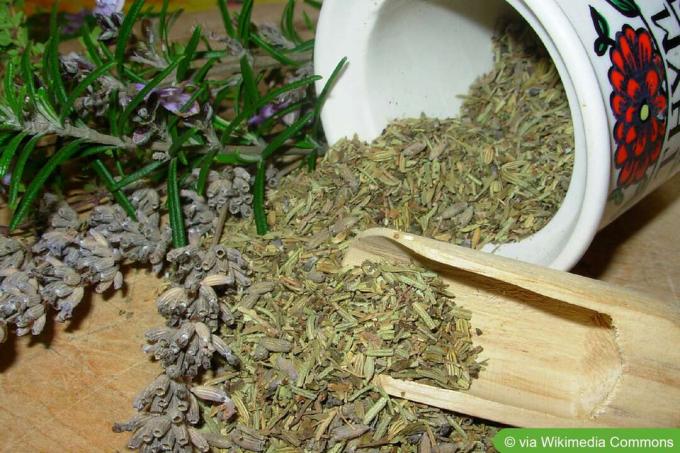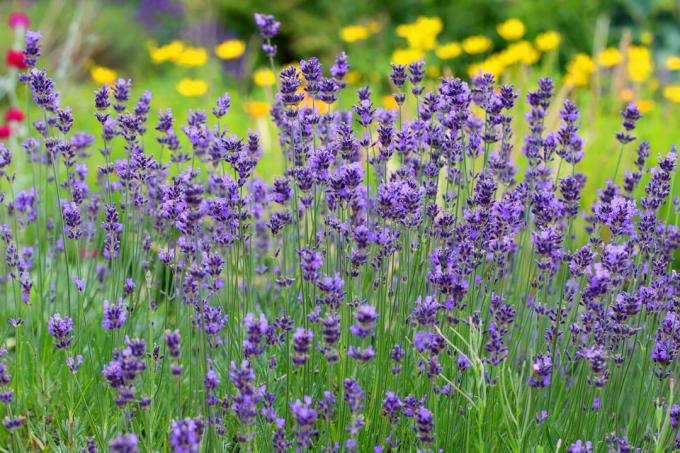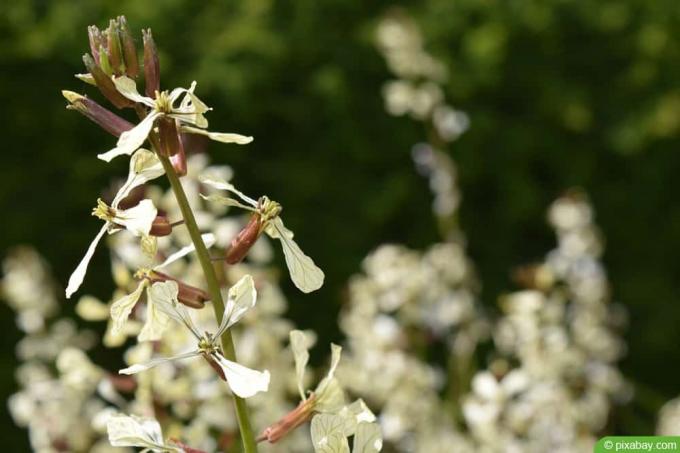

Table of contents
- Mixture of different herbs
- Use fresh herbs
- Store dry
- Make your own flavored vinegar
- Make your own spice oil
- Spoiled spice oil
- use
- frequently asked Questions
- Worth knowing about herbs de Provence
The term "herbs of Provence" is not protected, any spice mixture may be called that, and by far not all herbs or mixtures that are traded actually come from the Provence. Originally the term meant a mixture of spices that grow wild in Provence - but who collects wild herbs in southern France these days? You don't have to do that, because the herbs of Provence have long been growing in German gardens, on balconies and on windowsills.
Mixture of different herbs
The basic mixture actually consists of thyme, rosemary and oregano, marjoram and savory. However, you can add other ingredients if you like. Basil or tarragon are often used, and fennel, chervil, laurel, aniseed, parsley and sage are also found. Lavender leaves or blossoms are very often included in finished mixtures - this is very tasty, but has nothing to do with the actual mixture of herbs from Provence. The herbal mixture is basically very aromatic and smells as intense as it tastes. Fresh herbs are commercially available as a mixture, but dried herbs and seasoning oil and vinegar are also available.
Use fresh herbs
Herbs that are cut in the morning just after sunrise are best. During the night the plants rest, they regenerate, and in the morning the sun does not yet have the strength to pull the water out of the leaves. Fresh, crisp leaves are obtained before the sun develops a lot of strength in the morning. The whole plant is never used: the leaves are plucked from the thyme, oregano, marjoram and savory, and the needles from the rosemary. It doesn't matter if a bit of a stalk gets in between when chopping the cleaned herbs, it's also edible. However, the stem is bitter and not as aromatic as the leaves.
Store dry
Fresh herbs are never dried in the direct sun, but in a shady, airy place. To do this, a few branches of the herbs are cut off as close as possible to the base and loosely tied together. Hang these bundles upside down in a breezy, cool place out of direct sunlight. How exactly the mixing ratio turns out is a matter of taste. Some prefer herbal mixtures in which the spicy savory dominates, others like the freshness of rosemary or the spiciness of thyme. If you haven't done this that often, you can experiment with different herb bundles. The bundles are easy to store and process if one portion is combined at a time, which is used at a meal. If the herbs are so dry that the leaves crumble between your fingers when you touch them, they can be packaged to retain their aroma and stored in a cool, dark place. Plastic jars and bags are not good for storing herbs because the aroma transfers to the packaging.
Make your own flavored vinegar
Spicy vinegar is a vinegar that has been flavored by adding herbs and storing it for a long time. To do this, the herb branches are completely covered with vinegar, the vinegar bottle is sealed airtight and left for several weeks. After that, the herbs must be taken out before the vinegar is used. Thyme, rosemary, oregano, marjoram and savory sprigs are cut and cleaned for the Herbs de Provence seasoning vinegar. The branches are placed in a bottle of vinegar and the bottle is sealed and stored. There should be at least one sprig of each type of herb in the bottle, depending on the desired intensity of taste and the size of the vinegar bottle, more can be used. It has to be a light-colored, neutral vinegar, pre-seasoned vinegars and fruit vinegars and the like have one such a strong taste of its own that the herbs do not taste through or the taste is falsified becomes.
Before use, the herbs are removed from the vinegar, which may need to be filtered. And it's completely normal that the color isn't the same as it was before storage - along with the aromas of the herbs, coloring components have also migrated into the vinegar. Fresh herbs are always used to produce seasoning vinegar, as the dried leaves no longer have enough aroma.
Make your own spice oil
Essentially, spice oil is made in the same way as vinegar. At least one branch of each herb is cleaned and dried in a bottle of neutral Vegetable oil hung, the bottle is sealed and stored in a cool, dark place for several weeks stored. Before use, the herbs are taken out of the bottle and the oil is filtered if necessary. It is completely normal that it now has a different color than before storage, because the aromas and essential oils of the herbs have also released coloring components from the oil. A neutral oil such as sunflower oil, corn oil or rapeseed oil is ideal for the production of seasoning oil because these oils do not have a strong taste of their own. Strongly aromatic oils such as olive oil or walnut oil are extremely unsuitable. Fresh herbs are always used for the production of spice oil.
Spoiled spice oil
If the herbs were not dried properly before pickling or were contaminated in any way, bacteria can multiply in the oil, which usually secrete toxic substances. You can tell by the fact that the oil bubbles, foams, and the bottle is under pressure or hisses when you open it. Under no circumstances should this oil be used again!
use
Herbs de Provence can be used fresh for fish and meat, vegetables, salads, pizza, bread, pasta and more. Fresh herbs taste intense, they are dosed more carefully than dried herbs. The dried spice mixture is used in the same way, only in higher doses. Seasoning vinegar cannot be used when cooking, it is more for the marinade. Vegetables are pickled in it, but meat and fish can also be acidified in it before they are used. Vinegar is used for all kinds of salads, and can be carefully dosed as a seasoning for vegetables and meat dishes.
frequently asked Questions
If the spiced vinegar you prepared yourself becomes moldy, the herbs were not completely covered with vinegar or the vinegar contains too little sugar. Moldy vinegar must no longer be used, even if the mold only floats on the surface!
Seasoning oil is used in marinades and as a sauce. You don't necessarily have to marinate meat and fish, vegetables and raw vegetables with a mixture of fresh herbs, seasoning oil is also suitable. This is then used in correspondingly small quantities and not rinsed off before further processing. It can serve as a dressing on salads, and of course it can also be used when baking bread or as a spread, when roasting, roasting and grilling.
The herbs of Provence are not a fixed mixture, if you like you can of course mix in hyssop. Hyssop isn't actually one of them, and it's nonsense in a dried mix, as most of the flavors of this plant are lost in the drying process.
Worth knowing about herbs de Provence
The "Herbs of Provence" in the various mixtures are:
- Basil,
- savory,
- Chervil,
- Lavender,
- Fennel,
- Tarragon,
- Laurel,
- lovage,
- Marjoram,
- Oregano,
- Rosemary,
- Thyme,
- juniper
- and garlic.
use
The herbs of Provence can be used to decorate salads and to enhance the flavor of numerous dishes such as poultry and soups. Herbs de Provence can also be bought as a dressing. The herbal mixture is very good for the stomach and thanks to its essential oils, it also supports digestion.
Grow yourself
- All of the herbs mentioned can be bought commercially as seeds and cultivated in the garden.
- It can only be difficult in winter, some tolerate little or no frost.
- The commercially available planters with a ready-made seed mixture are suitable for the windowsill.
- On the balcony or terrace you can grow the herbs in window boxes or planters.
- You can sow seeds yourself or get ready-made plants and plant them.
Growing herbs in the garden is not a problem either. A herb spiral is particularly suitable, because there you can offer the plants different habitats, depending on their needs. Herbs that like it dry are planted upwards towards the top. Those with normal needs go in the middle and those that need more moisture go at the bottom. Such a herb spiral can be an absolute eye-catcher in the garden.
 garden editorial
garden editorial I write about everything that interests me in my garden.
Learn more about garden herbs

Lady's mantle: 9 tips for planting, caring for and cutting
The lady's mantle can be found in almost every garden. There are around 1,000 different species. Here's the best time to plant it and how to care for it. it is also clarified whether and how it has to be cut.

Lavender, Lavandula angustifolia: 14 tips of care
Compared to other lavender varieties, Lavandula angustifolia is hardy down to temperatures of -15°C. In addition, he does not place very high demands on the location. It only needs to be sunny and sheltered from the wind and it loves lean, well-drained and calcareous soil.

Rosemary leaves have white spots: what to do?
Rosemary can be affected by white spots all year round. Before using home remedies, the problem should be investigated. If site conditions and care measures are optimal, diseases and pests can be the cause. Fungi require different control measures than harmful insects.

Rocket is blooming: is it still edible when blooming?
Rocket, also known as rocket, is a traditional cultivated plant that has been somewhat forgotten in recent years. It is now back in fashion and can be found in numerous dishes as a raw vegetable salad, side dish or herb.

Make your own mint tea – What is the effect of fresh mint tea?
Mint tea tastes best when you brew it from freshly picked mint leaves. In this way, the aromatic herb unfolds its healing effect against all kinds of ailments. However, there are also contraindications, because fresh mint tea can also have undesirable side effects.

Harvest peppermint when it blooms? | What to watch out for with mint
Due to its spicy flavor and easy-care properties, peppermint has become widespread in the local latitudes. Only the leaves need to be harvested for consumption. However, there are a number of factors to consider during the flowering period, as the flavor then changes significantly.



